Great Blue Heron Nests and Rookery at the Ballard Locks in Seattle
A few weeks ago, I walked by the Great Blue Heron rookery a short distance from our place at the Ballard Locks in Seattle. I expected to see the six or eight heron couples, draped over their nests in anticipation of egg hatching … or maybe even the first raspy calls of young chicks rustling in the alders.
Instead, this is who came my way.
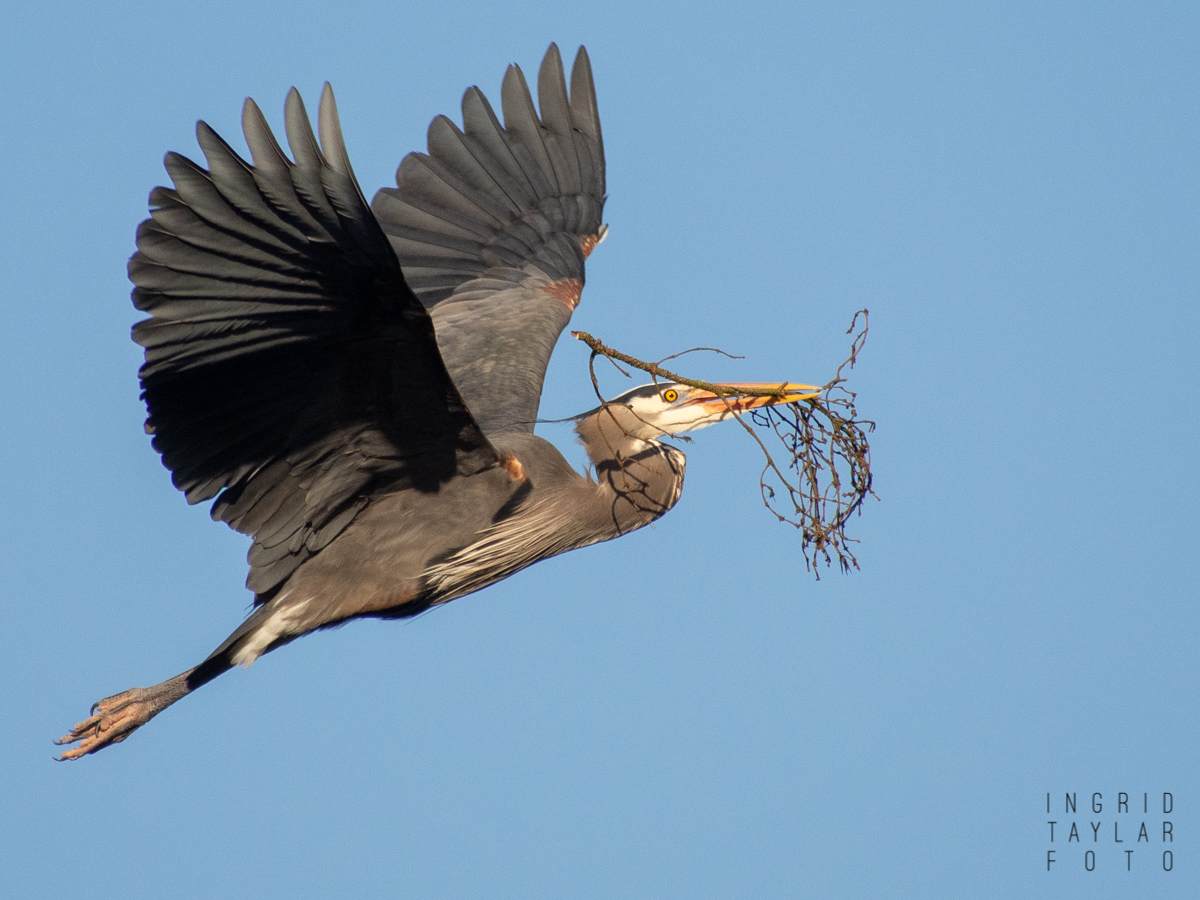
And then another Great Blue, bearing the sign of beginnings … not of hatchings.
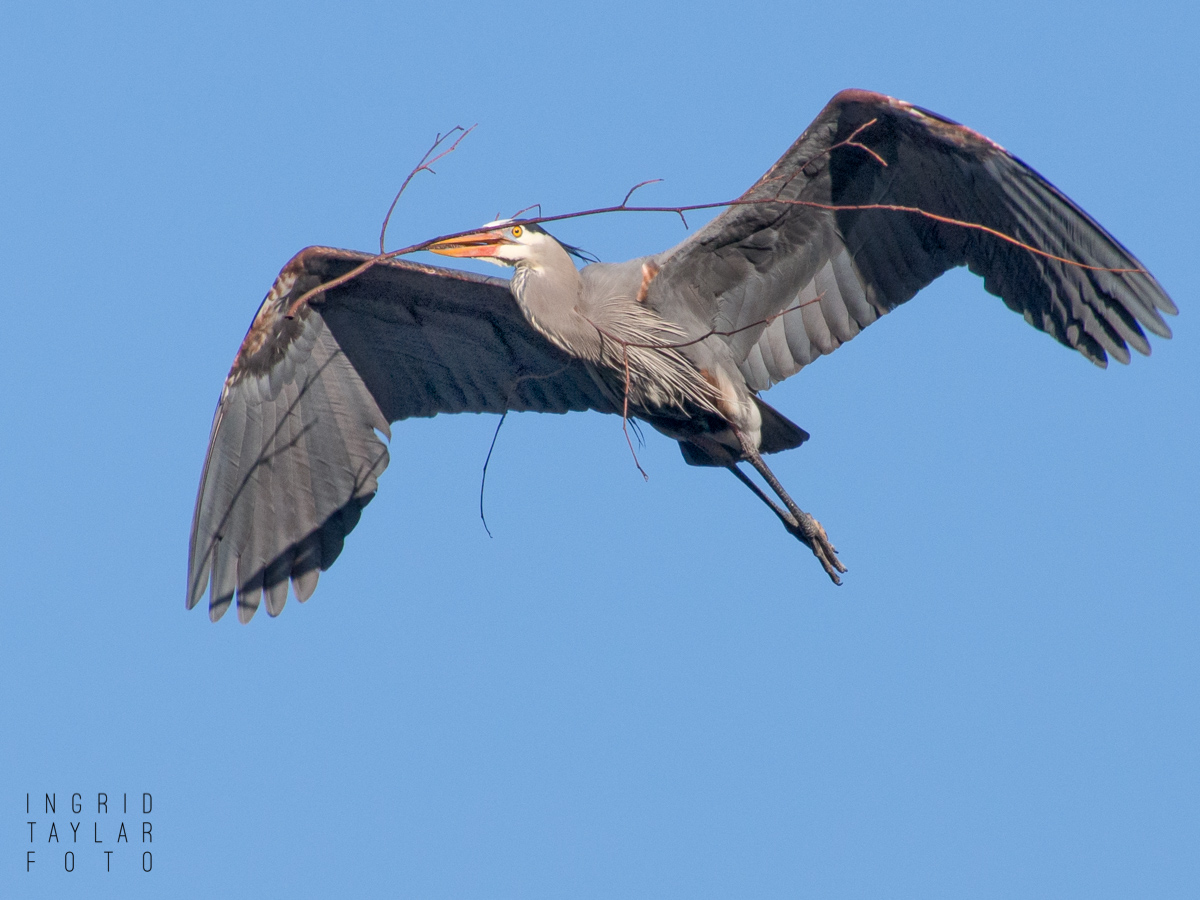
One after the other — herons flew toward their mother ship of a rookery, like birds caught in a tractor beam.
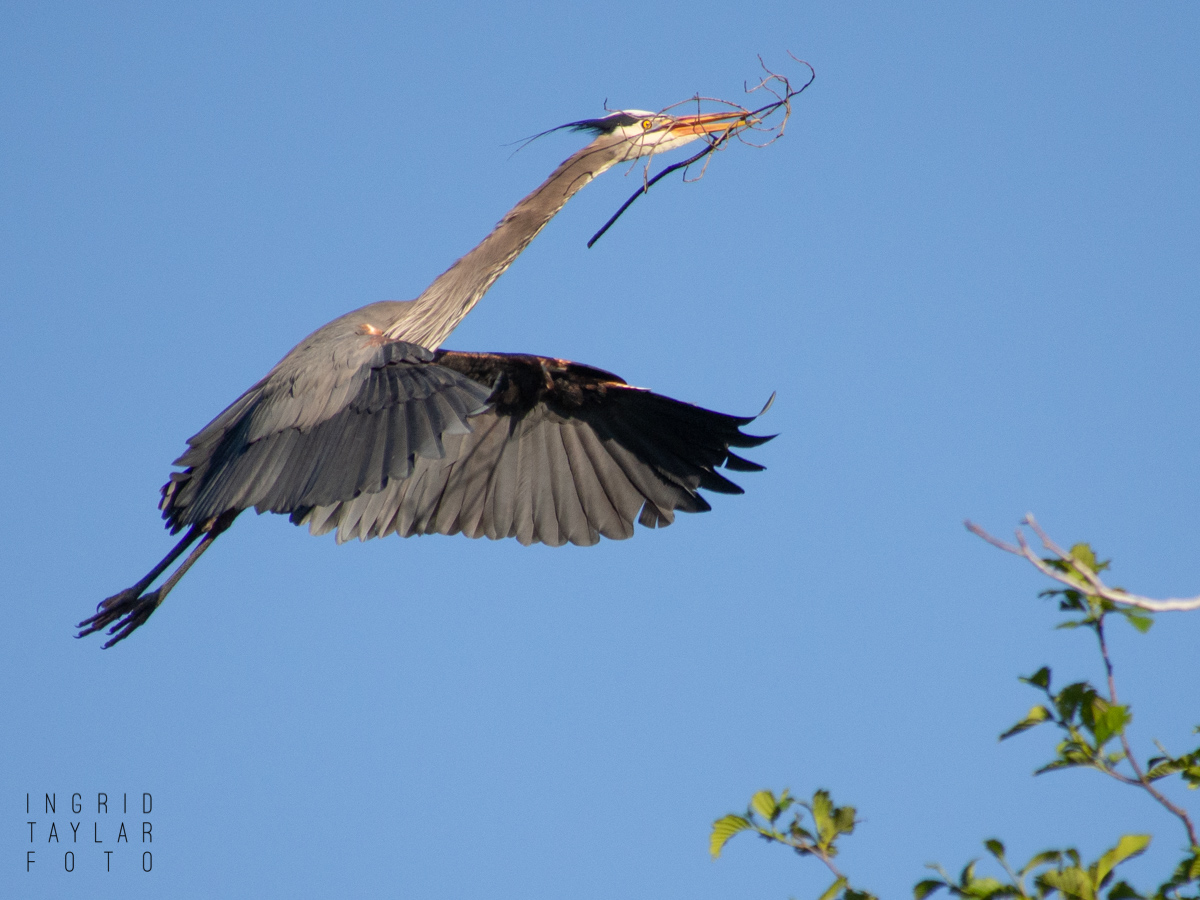
I couldn’t keep an accurate count with incoming, outgoing and circling traffic, but it was clear our intimate rookery over the promenade was quickly bursting at the leaves.
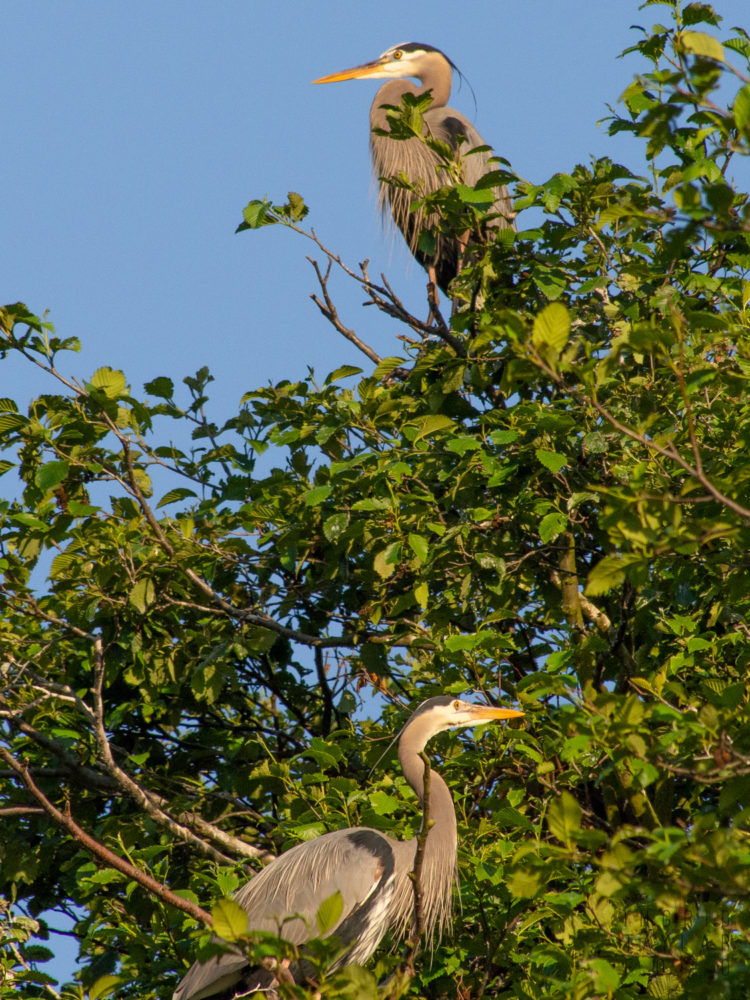
Great Blue Herons in Seattle Rookery
I knew something was amiss, but I didn’t know the extent of it … until I got home. I logged in with our local group, Heron Habitat Helpers and learned that the larger rookery uphill from our little public one had been disrupted by a juvenile Bald Eagle who was caught on webcam, eating some of the eggs. At the time of my checking, 70 of the 90 nests were destroyed.
My heart sank. This explained the influx of heron builders over the park promenade.
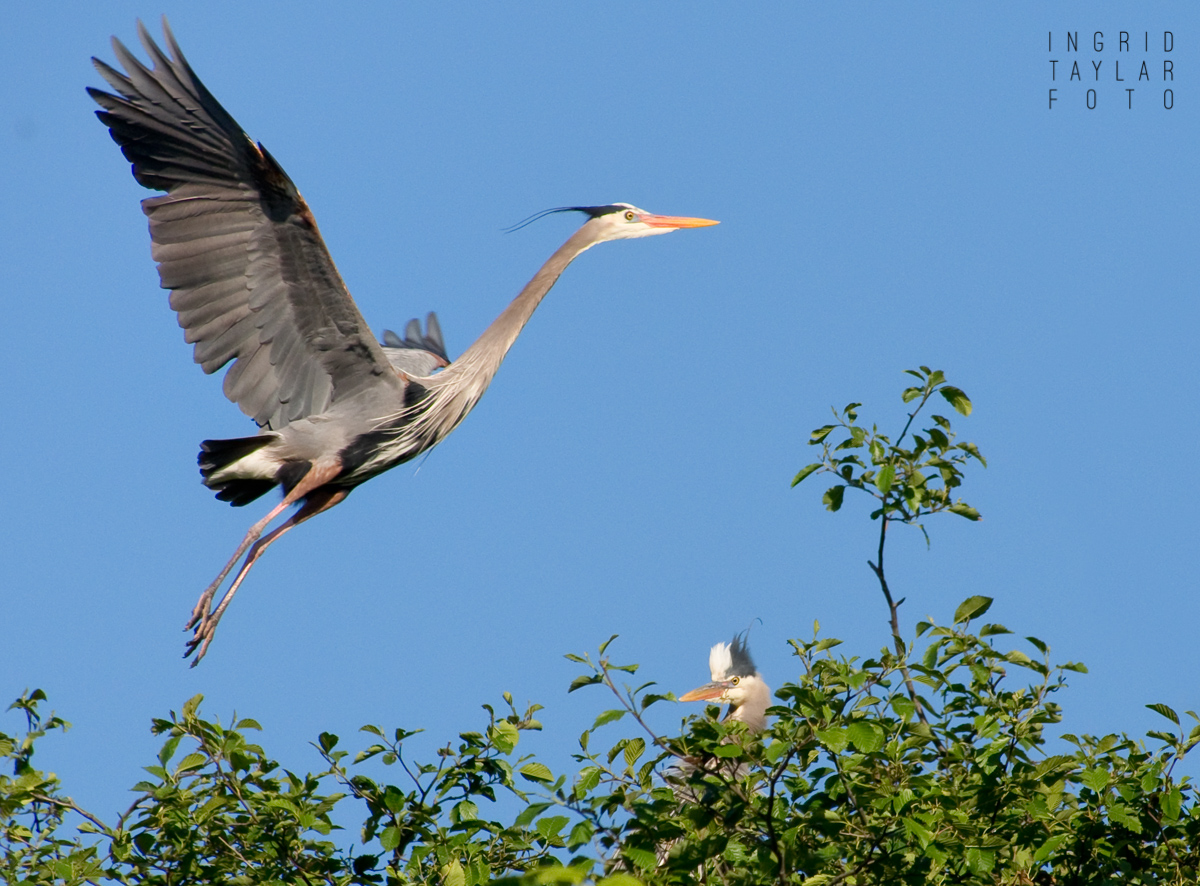
Bald-Eagle-Great-Blue interactions are not uncommon and can produce significant casualties for the herons who are mismatched, to their clear disadvantage. Other raids have occurred at this very rookery, before I moved to the neighborhood. A rookery south of Seattle in Renton was attacked by Bald Eagles after the eagles were pushed from their habitat by a development project.
Various factors contribute to increasing conflicts between these species, among them, a rise in Bald Eagle numbers combined with a reduction of suitable habitat for all wildlife, as in the case of the Renton eagles who were pushed out of their turf by a new apartment complex. Eagles are also known to be adaptable in terms of their food sources, relying more on terrestrial animals or birds when marine foods aren’t as readily available. All wild animals, including Bald Eagles, are doing their best to survive in the face of human expansion and, often, encroachment.
The issues of habitat preservation, restoration and resource depletion are the huge, overarching ones. But one heron-specific solution that’s been proposed is to place Osprey platforms near rookeries, since the presence of Ospreys can deter the eagles. Last year, I photographed this tenacious male Osprey who chased away two Bald Eagles from the cove near his nesting platform.
During the week after I first documented the branch-bearing herons, I returned to the park to watch the avian house builders again. I posted to my Facebook page that I stood for an hour that first day, mesmerized by this testament to renewal. In the end, there were 40+ new nests and trees full of heron chatter.
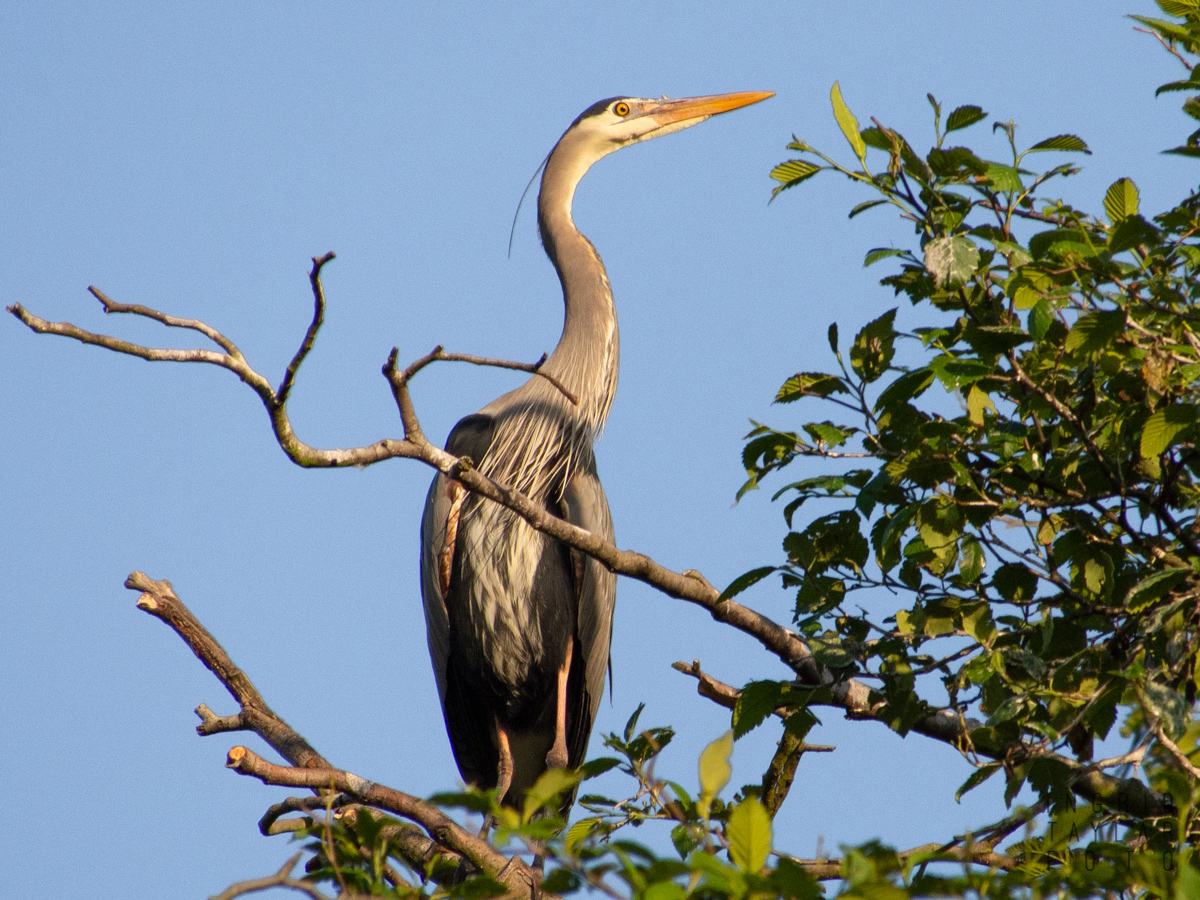
Some people will argue that animals can move forward in their lives after trauma because they don’t share our emotional complexity. I refuse to simplify their experience, even though we can never be sure what their psychological response is to stress. I ran into a gentleman who lives next to another small nesting area north of Seattle. He said there was an eagle incident at that site a few years prior, and his words to me were, “I never want to witness something like that again. The distress of the birds was difficult to bear.” The undeniable fact is that in the wild, there’s an imperative of immediacy: you move on because you have no choice.
Whatever their motivations and emotions might be, it’s often something as simple as a heron with a branch that reminds me to be resilient. I think the same thing when I see a gull or a pigeon foraging for supper with just one leg, the other leg either missing or limp. In those moments, although I’m reticent to compare, I do think they are better than I am … for the tenacity with which they endure and overcome life’s travails without much complaint or wavering. I’ve resolved at this point in my life, that they are clearly my teachers. It is definitely not the other way around.
All images photographed with the Olympus OM-D E-M5 + Lumix 100-300mm (micro four thirds). My Olympus E-3 workhorse is in the shop until I don’t know when.
EDITED TO ADD a few Great Blue Heron nesting images from the 2014 nesting season at the Ballard Locks and Commodore Park:
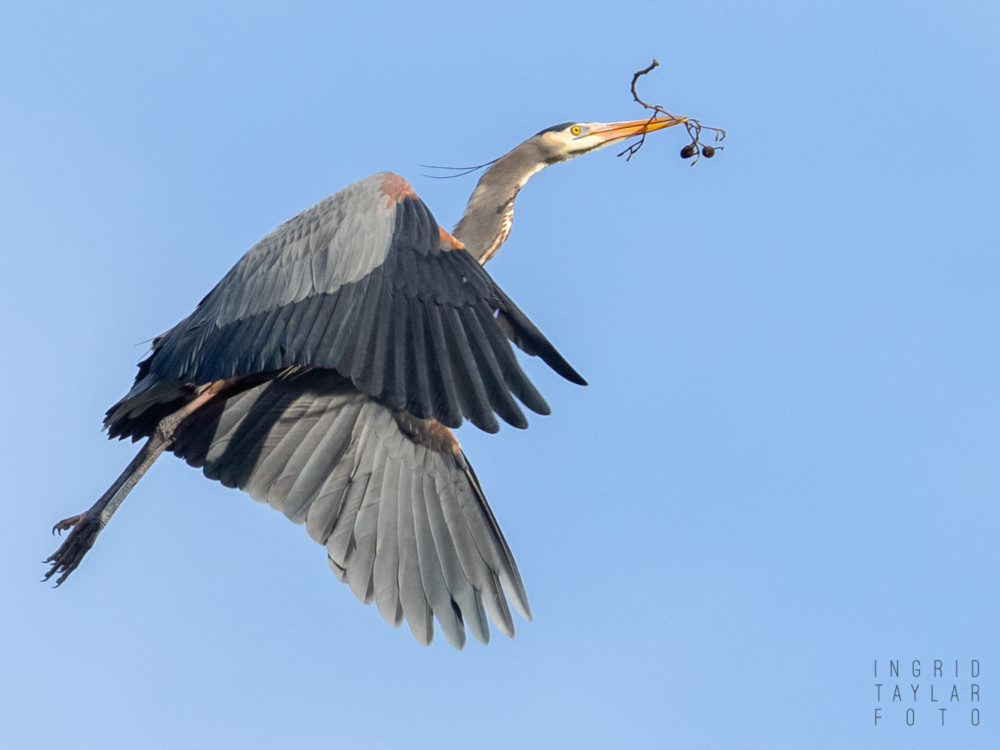
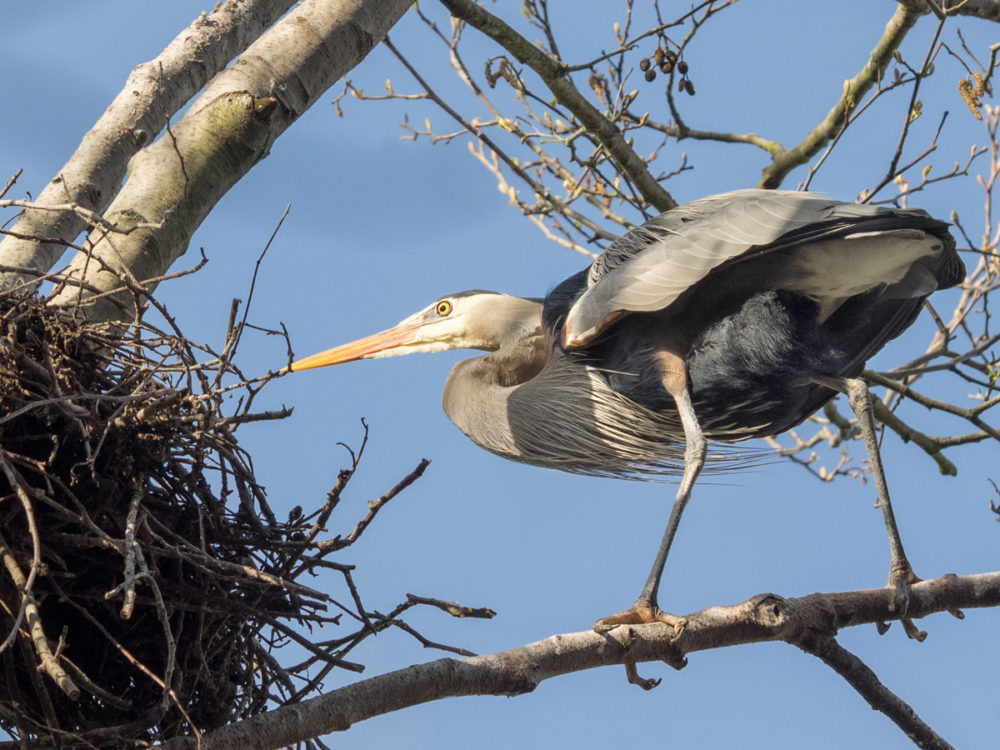
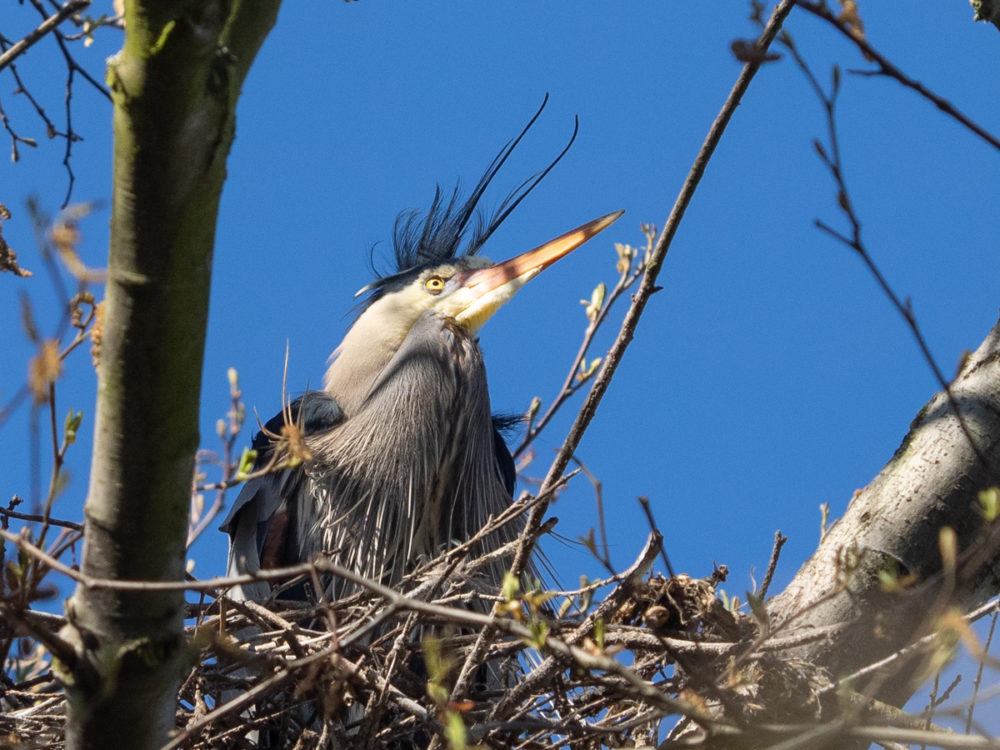
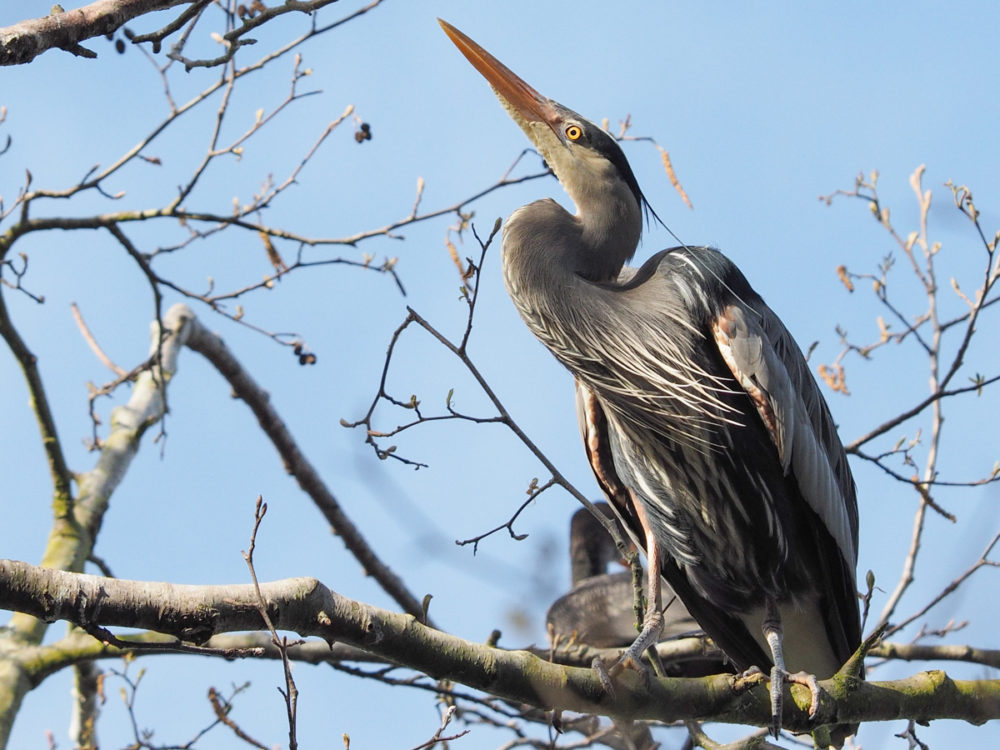
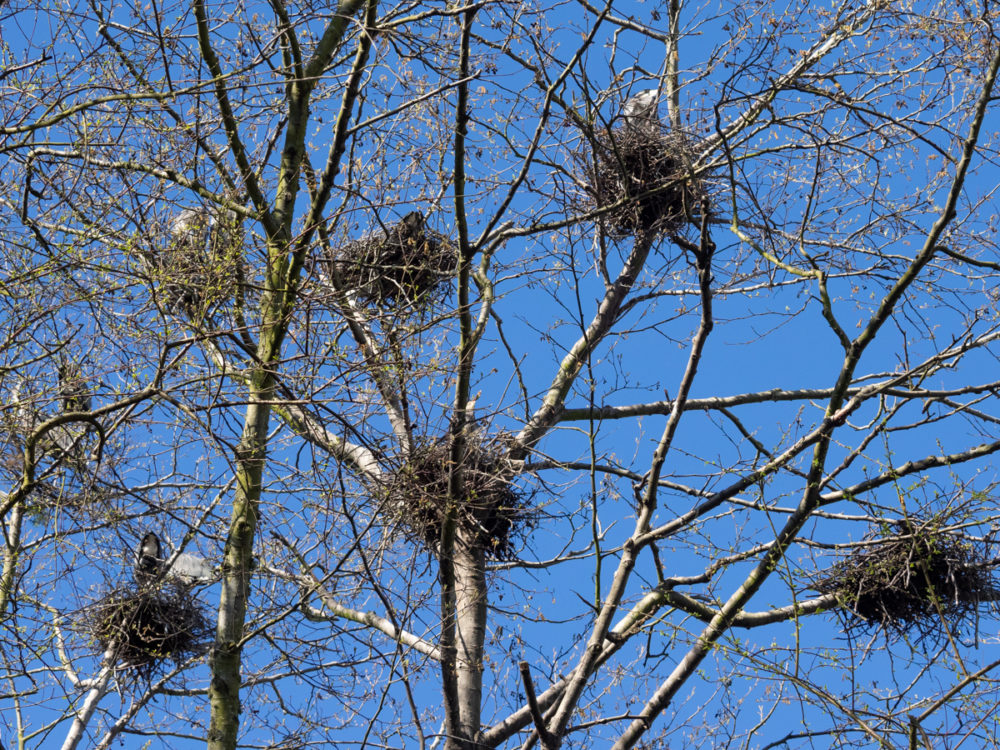

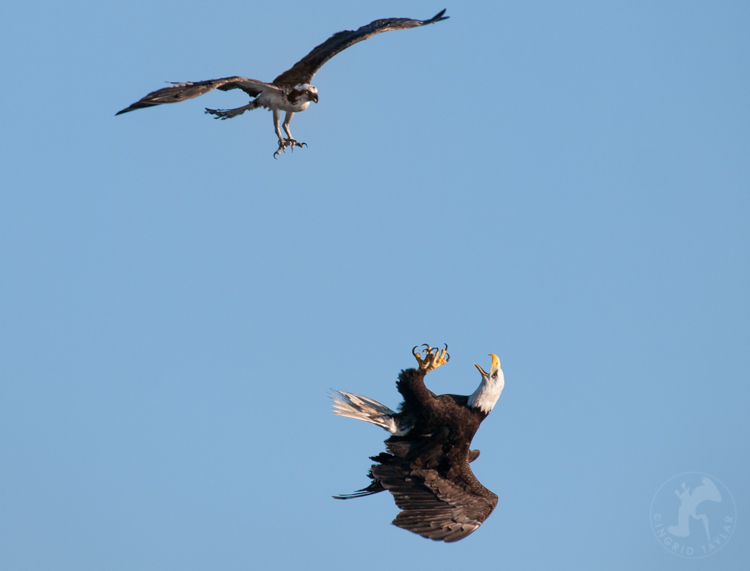
I would like to reprint these words, without comment. They stand on their own lovely legs.
I ran into a gentleman who lives next to another small nesting area north of Seattle. He said there was an eagle incident
at that site a few years prior, and his words to me were, “I never want to witness something like that again. The
distress of the birds was difficult to bear.” The undeniable fact is that in the wild, there’s an imperative of immediacy:
you move on because you have no choice.
Whatever the motivations and emotions of Great Blue Herons and great Bald Eagles might be, I marvel that something
as simple as a heron with a branch reminds me to be resilient. I think the same thing when I see a gull or a pigeon
foraging for supper with just one leg, the other leg either missing or limp and entwined in fishing filament. In those
moments, although I’m reticent to compare, I do think they are better than I am … for the tenacity with which they
endure and overcome life’s travails without much complaint or wavering. I’ve resolved at this point in my life, that they
are clearly my teachers. It is definitely not the other way around.
Under these same circumstances, humans would have sued the Bald Eagles and would have sought all sorts of counseling for solving this situation. It would have gone to court. It would have costed money. Human resilience seems so different from that of nature’s. It is felt at a psychological level rather than the biological and instinctive from nature which just seems to flow.
Thanks CQ. And Maria, you’re right about the lawsuit. I think some of the differences lie in how far we are from, again, the actual imperative of baseline survival. Do you think the differences would be as pronounced if our situations were comparable to theirs?
If humankind were to undergo a natural disaster and stripped off of absolutely everything they own; down to having to reconstruct everything and rebuild a new civilisation, only then I think we would be somewhat comparable to the Great Blue Herons, although I think humans could behave pretty much like the herons if survival of their offspring was at stake, probably because the motherly instinct could be very similar. However, given that humans form such complex societies and hierarchies where multiple members exert control over others, it seems the psychological reaction could override the instinctual one.
It’s amazing, but I happened to stumble upon a great documentary film called: ‘Life After People’. It’s really a speculation about the environment if humans were totally wiped out, but based on factual truths. It’s full of great photography and time-lapse video with special effects. It was produced by the History channel. You can watch here:
https://topdocumentaryfilms.com/life-after-people/
Maria, I think I may have seen at least part of that documentary, but I need to look through the clip to see if it’s the same film. If so, it was actually very hopeful for those of us who understand what we humans are doing. I know there are people who would find it horrifying … I mean, a planet without us.
There is another version on this theme produced by National Geographic:
https://www.youtube.com/watch?v=wQjStEK47HI
You are so right about the trials and difficulties nonhumans endure simply because they have to. But I don’t think we are any different. I’m always surprised when people pick up and go step by step after a tragic loss. We’re like them… We do it because there’s no other choice. That’s life.
I’m reminded of a recent event that happened in my yard. There was a terrible storm that blew out an occupied nest. The chicks were hardly hatched a day or so. All perished. After a proper burial, the next day I watched the two cardinals as they chirped and chattered for most of the morning. They were unusually vocal. I’m sure part of it was mourning their loss. Perhaps they were even passing blame and bickering. (?) But I’m certain too that in all squawking they finally settled on a new, better plan. I think this was their first nest… Life is full of lessons. And you are so right about resiliency!
Love this post! Thank you.
Bea, I would like to believe I am, and I have to work hard and steady to develop spiritual growth to become similar to the herons, but I don’t think humanity may be in general. People go through trials and tribulations, and stages of denial, and there are individuals who may actually not recover at all. It’s called the “psychological scar”, “trauma”, well, I could go on with all the names it has (PTSD among others). Unfortunately humans are plagued with it; and this is what sets us apart, I think. This is what makes individuals pull the trigger at movie theatres and public schools; this is what provokes suicide bombers. I work with sick people and I see how people carry their ‘psychological scars’ up until their moment of death. Science likes to link it to genetics, and that could play a part, but I think it goes beyond. I think humans have many ‘psychological scars’ and to me it proves that most individuals are far from being resilient.
I agree with you M. Firpi – We do have the burden of psychological scars… Sadly most of them are of our own making although the consequences usually fall to other victims as well. We can only keep sending out a “great blue” blue-print for a better way and keep hope as a point of un-extinguishable light.
Yes, and I believe in hope, as when I see or deal with someone who may be ’emotionally scarred’, I immediately detach myself from this ‘scarring’ or ‘grudge’; and I still accept the person as he/she is. I don’t reject someone who I know could be potentially dangerous because this is how fear nourishes itself. This is what in Buddhism is called ‘equanimity’; it has taken me years to learn, but for me it works and the person also gets the message too, I believe. I send them the light, as you say.
Resilience indeed! The incredible work that birds go through every year to raise their young always amazes me. The intricate nest building activities followed by the seemingly endless hours and days of incubating the eggs and finally the daily search for food to feed the young. All this with the threat of intrusion and possible destruction from so many sources it’s a wonder that so many birds survive the ordeal.
This destruction by the Bald Eagles is something I had never heard of before but it doesn’t surprise me. Bald Eagles are opportunistic feeders as well as scavengers and when their normal food supply is diminished they seek other solutions.
Your photographic documentation of the Great Blue Herons re-nesting in a new location is absolutely beautiful Ingrid. I love all the in-flight shots of the birds carrying their nesting materials but I must say your award winning photograph of the Osprey and the Bald Eagle encounter blew me away! Wow! What an incredible capture of these two raptors, ready for battle with talons drawn. I know how quickly those inverse defensive flights disappear and somehow you managed to catch that exact moment on film with perfection. Thank you for sharing both the Blue Heron story and the magical raptor photo all in one post!